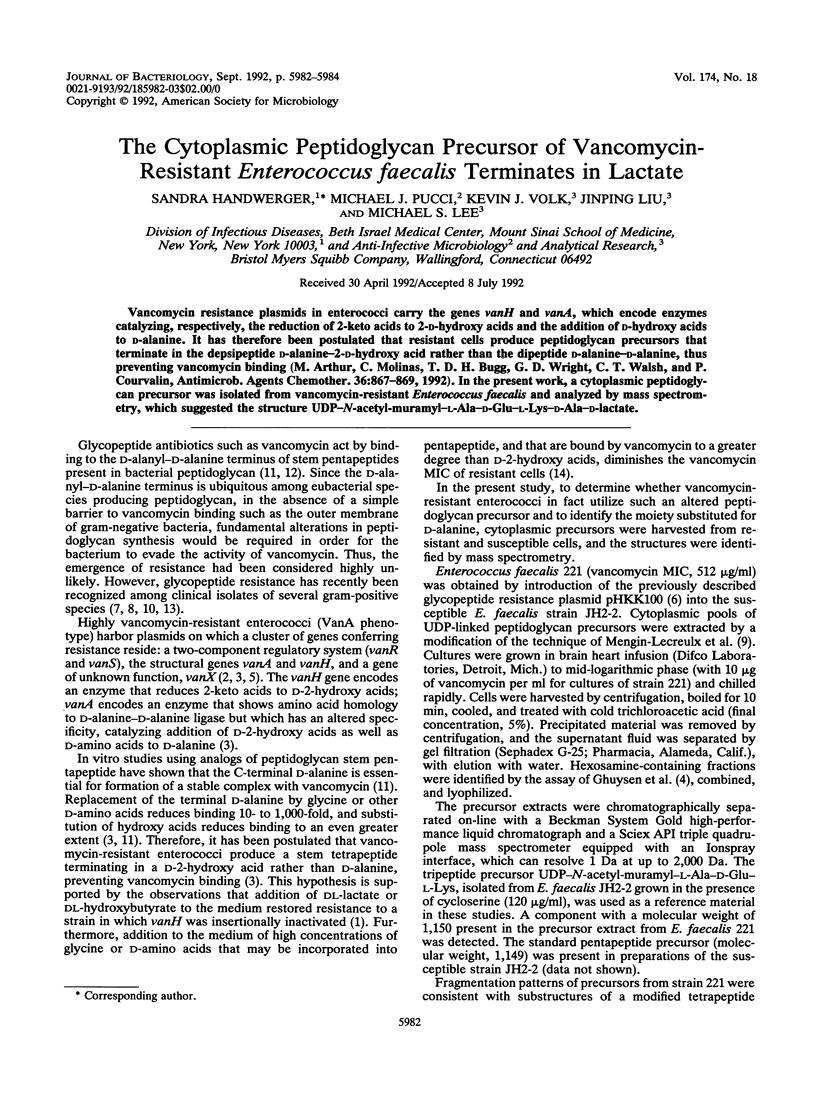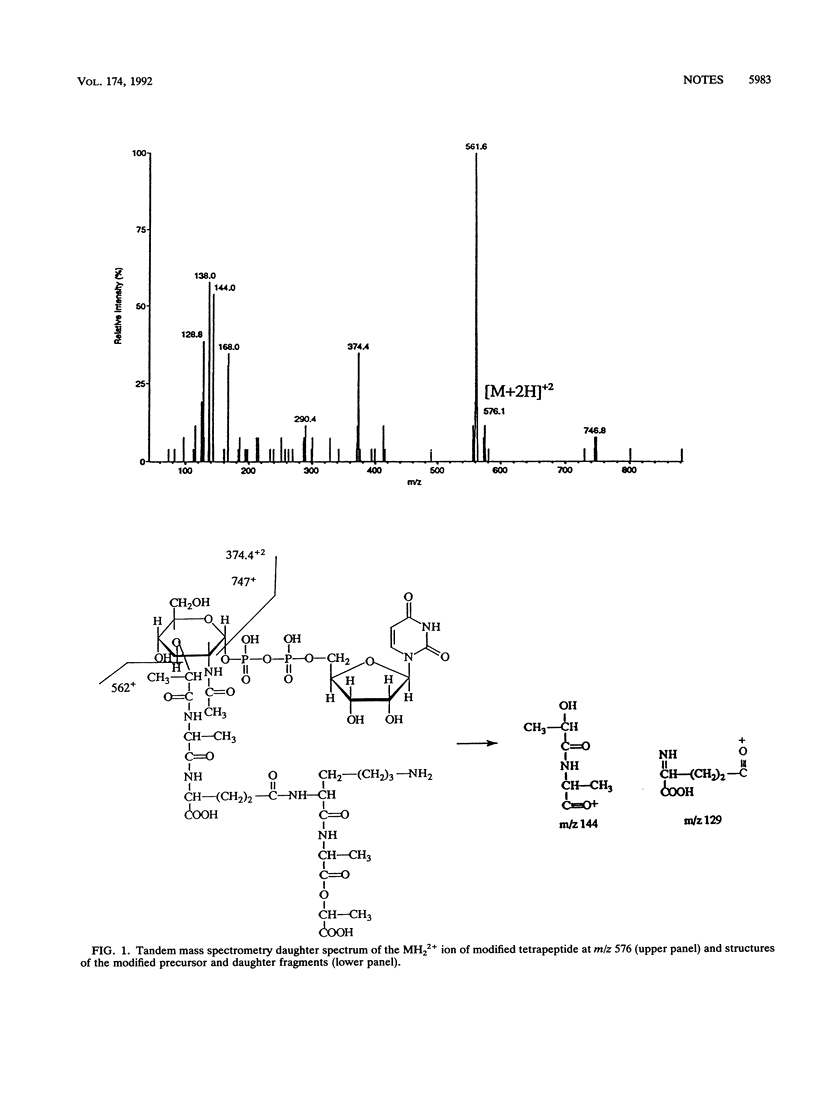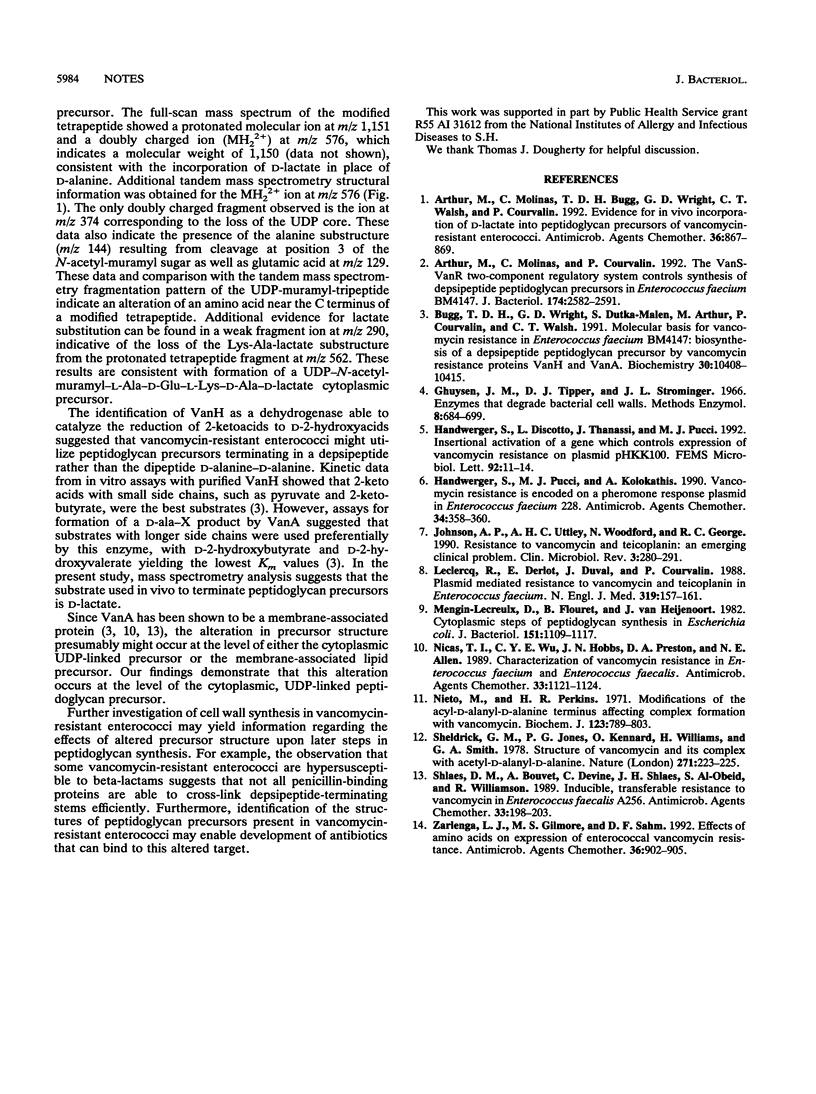Abstract
Vancomycin resistance plasmids in enterococci carry the genes vanH and vanA, which encode enzymes catalyzing, respectively, the reduction of 2-keto acids to 2-D-hydroxy acids and the addition of D-hydroxy acids to D-alanine. It has therefore been postulated that resistant cells produce peptidoglycan precursors that terminate in the depsipeptide D-alanine-2-D-hydroxy acid rather than the dipeptide D-alanine-D-alanine, thus preventing vancomycin binding (M. Arthur, C. Molinas, T. D. H. Bugg, G. D. Wright, C. T. Walsh, and P. Courvalin, Antimicrob. Agents Chemother. 36:867-869, 1992). In the present work, a cytoplasmic peptidoglycan precursor was isolated from vancomycin-resistant Enterococcus faecalis and analyzed by mass spectrometry, which suggested the structure UDP-N-acetyl-muramyl-L-Ala-D-Glu-L-Lys-D-Ala-D-lactate.
Full text
PDF


Selected References
These references are in PubMed. This may not be the complete list of references from this article.
- Arthur M., Molinas C., Bugg T. D., Wright G. D., Walsh C. T., Courvalin P. Evidence for in vivo incorporation of D-lactate into peptidoglycan precursors of vancomycin-resistant enterococci. Antimicrob Agents Chemother. 1992 Apr;36(4):867–869. doi: 10.1128/aac.36.4.867. [DOI] [PMC free article] [PubMed] [Google Scholar]
- Arthur M., Molinas C., Courvalin P. The VanS-VanR two-component regulatory system controls synthesis of depsipeptide peptidoglycan precursors in Enterococcus faecium BM4147. J Bacteriol. 1992 Apr;174(8):2582–2591. doi: 10.1128/jb.174.8.2582-2591.1992. [DOI] [PMC free article] [PubMed] [Google Scholar]
- Bugg T. D., Wright G. D., Dutka-Malen S., Arthur M., Courvalin P., Walsh C. T. Molecular basis for vancomycin resistance in Enterococcus faecium BM4147: biosynthesis of a depsipeptide peptidoglycan precursor by vancomycin resistance proteins VanH and VanA. Biochemistry. 1991 Oct 29;30(43):10408–10415. doi: 10.1021/bi00107a007. [DOI] [PubMed] [Google Scholar]
- Handwerger S., Discotto L., Thanassi J., Pucci M. J. Insertional inactivation of a gene which controls expression of vancomycin resistance on plasmid pHKK100. FEMS Microbiol Lett. 1992 Apr 1;71(1):11–14. doi: 10.1016/0378-1097(92)90533-t. [DOI] [PubMed] [Google Scholar]
- Handwerger S., Pucci M. J., Kolokathis A. Vancomycin resistance is encoded on a pheromone response plasmid in Enterococcus faecium 228. Antimicrob Agents Chemother. 1990 Feb;34(2):358–360. doi: 10.1128/aac.34.2.358. [DOI] [PMC free article] [PubMed] [Google Scholar]
- Johnson A. P., Uttley A. H., Woodford N., George R. C. Resistance to vancomycin and teicoplanin: an emerging clinical problem. Clin Microbiol Rev. 1990 Jul;3(3):280–291. doi: 10.1128/cmr.3.3.280. [DOI] [PMC free article] [PubMed] [Google Scholar]
- Leclercq R., Derlot E., Duval J., Courvalin P. Plasmid-mediated resistance to vancomycin and teicoplanin in Enterococcus faecium. N Engl J Med. 1988 Jul 21;319(3):157–161. doi: 10.1056/NEJM198807213190307. [DOI] [PubMed] [Google Scholar]
- Mengin-Lecreulx D., Flouret B., van Heijenoort J. Cytoplasmic steps of peptidoglycan synthesis in Escherichia coli. J Bacteriol. 1982 Sep;151(3):1109–1117. doi: 10.1128/jb.151.3.1109-1117.1982. [DOI] [PMC free article] [PubMed] [Google Scholar]
- Nicas T. I., Wu C. Y., Hobbs J. N., Jr, Preston D. A., Allen N. E. Characterization of vancomycin resistance in Enterococcus faecium and Enterococcus faecalis. Antimicrob Agents Chemother. 1989 Jul;33(7):1121–1124. doi: 10.1128/aac.33.7.1121. [DOI] [PMC free article] [PubMed] [Google Scholar]
- Nieto M., Perkins H. R. Modifications of the acyl-D-alanyl-D-alanine terminus affecting complex-formation with vancomycin. Biochem J. 1971 Aug;123(5):789–803. doi: 10.1042/bj1230789. [DOI] [PMC free article] [PubMed] [Google Scholar]
- Sheldrick G. M., Jones P. G., Kennard O., Williams D. H., Smith G. A. Structure of vancomycin and its complex with acetyl-D-alanyl-D-alanine. Nature. 1978 Jan 19;271(5642):223–225. doi: 10.1038/271223a0. [DOI] [PubMed] [Google Scholar]
- Shlaes D. M., Bouvet A., Devine C., Shlaes J. H., al-Obeid S., Williamson R. Inducible, transferable resistance to vancomycin in Enterococcus faecalis A256. Antimicrob Agents Chemother. 1989 Feb;33(2):198–203. doi: 10.1128/aac.33.2.198. [DOI] [PMC free article] [PubMed] [Google Scholar]
- Zarlenga L. J., Gilmore M. S., Sahm D. F. Effects of amino acids on expression of enterococcal vancomycin resistance. Antimicrob Agents Chemother. 1992 Apr;36(4):902–905. doi: 10.1128/aac.36.4.902. [DOI] [PMC free article] [PubMed] [Google Scholar]


